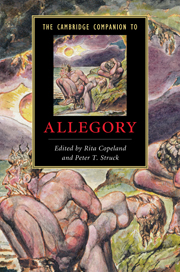Book contents
- Frontmatter
- Introduction
- Part I: Ancient foundations
- Part II: Philosophy, theology, and poetry 200 to 1200
- 4 Allegory and ascent in Neoplatonism
- 5 Allegory in Christian late antiquity
- 6 Allegory in Islamic literatures
- 7 Twelfth-century allegory: philosophy and imagination
- Part III: Literary allegory: philosophy and figuration
- Part IV: The fall and rise of allegory
- Further reading
- Index
6 - Allegory in Islamic literatures
from Part II: - Philosophy, theology, and poetry 200 to 1200
Published online by Cambridge University Press: 28 January 2011
- Frontmatter
- Introduction
- Part I: Ancient foundations
- Part II: Philosophy, theology, and poetry 200 to 1200
- 4 Allegory and ascent in Neoplatonism
- 5 Allegory in Christian late antiquity
- 6 Allegory in Islamic literatures
- 7 Twelfth-century allegory: philosophy and imagination
- Part III: Literary allegory: philosophy and figuration
- Part IV: The fall and rise of allegory
- Further reading
- Index
Summary
Allegory flourished in premodern Islamic literatures. Remarkably, however, neither premodern nor modern literary historians devote independent discussions to the genre per se, or even include the term in their indices. Allegorical praxis is simply treated under other generic categories, such as the mystical tale, the philosophical visionary recital, the poetic romance, or scriptural and textual commentary. Discussion here therefore requires drawing together variegated strands of literary practice to portray the history and development of allegory in Arabic, Persian, and Ottoman Turkish literatures, which are the major literary traditions of Islamic culture. Other Islamic literatures exist, in Urdu, Malay, and Swahili, for example, yet neither space nor scope of personal expertise allows their treatment here. Allegory in Islamic literatures as a developed literary practice begins at the turn of the eleventh century, four centuries after the death of the Prophet Muhammad. Yet allegory draws on earlier periods for crucial constituent narrative forms, topics, themes, source materials, and interpretational frameworks. An initial overview of relevant influences will clarify later developments.
The Qur’an influences allegorical practice in Islamic literatures in three significant ways. First, it dramatically emphasizes the existential and experiential duality that informs all allegorical writing. The Qur’an finds humans immersed in the immediate pleasures of corporeal sensation and worldly ambition. It calls on them to transcend these alluring earthly attachments and return to the “rightly guided path.” Humans, it states, must reorder their lives. Through divine mercy, God sends both prophets and revelation to guide this change in human orientation, with Muhammad being the last of such prophets and the Qur’an the final revelation.
- Type
- Chapter
- Information
- The Cambridge Companion to Allegory , pp. 83 - 100Publisher: Cambridge University PressPrint publication year: 2010
- 1
- Cited by



